I am trying to move data from a table in PostgreSQL table to a Hive table on HDFS. To do that, I came up with the following code:
val conf = new SparkConf().setAppName("Spark-JDBC").set("spark.executor.heartbeatInterval","120s").set("spark.network.timeout","12000s").set("spark.sql.inMemoryColumnarStorage.compressed", "true").set("spark.sql.orc.filterPushdown","true").set("spark.serializer", "org.apache.spark.serializer.KryoSerializer").set("spark.kryoserializer.buffer.max","512m").set("spark.serializer", classOf[org.apache.spark.serializer.KryoSerializer].getName).set("spark.streaming.stopGracefullyOnShutdown","true").set("spark.yarn.driver.memoryOverhead","7168").set("spark.yarn.executor.memoryOverhead","7168").set("spark.sql.shuffle.partitions", "61").set("spark.default.parallelism", "60").set("spark.memory.storageFraction","0.5").set("spark.memory.fraction","0.6").set("spark.memory.offHeap.enabled","true").set("spark.memory.offHeap.size","16g").set("spark.dynamicAllocation.enabled", "false").set("spark.dynamicAllocation.enabled","true").set("spark.shuffle.service.enabled","true")
val spark = SparkSession.builder().config(conf).master("yarn").enableHiveSupport().config("hive.exec.dynamic.partition", "true").config("hive.exec.dynamic.partition.mode", "nonstrict").getOrCreate()
def prepareFinalDF(splitColumns:List[String], textList: ListBuffer[String], allColumns:String, dataMapper:Map[String, String], partition_columns:Array[String], spark:SparkSession): DataFrame = {
val colList = allColumns.split(",").toList
val (partCols, npartCols) = colList.partition(p => partition_columns.contains(p.takeWhile(x => x != ' ')))
val queryCols = npartCols.mkString(",") + ", 0 as " + flagCol + "," + partCols.reverse.mkString(",")
val execQuery = s"select ${allColumns}, 0 as ${flagCol} from schema.tablename where period_year='2017' and period_num='12'"
val yearDF = spark.read.format("jdbc").option("url", connectionUrl).option("dbtable", s"(${execQuery}) as year2017")
.option("user", devUserName).option("password", devPassword)
.option("partitionColumn","cast_id")
.option("lowerBound", 1).option("upperBound", 100000)
.option("numPartitions",70).load()
val totalCols:List[String] = splitColumns ++ textList
val cdt = new ChangeDataTypes(totalCols, dataMapper)
hiveDataTypes = cdt.gpDetails()
val fc = prepareHiveTableSchema(hiveDataTypes, partition_columns)
val allColsOrdered = yearDF.columns.diff(partition_columns) ++ partition_columns
val allCols = allColsOrdered.map(colname => org.apache.spark.sql.functions.col(colname))
val resultDF = yearDF.select(allCols:_*)
val stringColumns = resultDF.schema.fields.filter(x => x.dataType == StringType).map(s => s.name)
val finalDF = stringColumns.foldLeft(resultDF) {
(tempDF, colName) => tempDF.withColumn(colName, regexp_replace(regexp_replace(col(colName), "[\r\n]+", " "), "[\t]+"," "))
}
finalDF
}
val dataDF = prepareFinalDF(splitColumns, textList, allColumns, dataMapper, partition_columns, spark)
val dataDFPart = dataDF.repartition(30)
dataDFPart.createOrReplaceTempView("preparedDF")
spark.sql("set hive.exec.dynamic.partition.mode=nonstrict")
spark.sql("set hive.exec.dynamic.partition=true")
spark.sql(s"INSERT OVERWRITE TABLE schema.hivetable PARTITION(${prtn_String_columns}) select * from preparedDF")
The data is inserted into the hive table dynamically partitioned based on prtn_String_columns: source_system_name, period_year, period_num
Spark-submit used:
SPARK_MAJOR_VERSION=2 spark-submit --conf spark.ui.port=4090 --driver-class-path /home/fdlhdpetl/jars/postgresql-42.1.4.jar --jars /home/fdlhdpetl/jars/postgresql-42.1.4.jar --num-executors 80 --executor-cores 5 --executor-memory 50G --driver-memory 20G --driver-cores 3 --class com.partition.source.YearPartition splinter_2.11-0.1.jar --master=yarn --deploy-mode=cluster --keytab /home/fdlhdpetl/fdlhdpetl.keytab --principal fdlhdpetl@FDLDEV.COM --files /usr/hdp/current/spark2-client/conf/hive-site.xml,testconnection.properties --name Splinter --conf spark.executor.extraClassPath=/home/fdlhdpetl/jars/postgresql-42.1.4.jar
The following error messages are generated in the executor logs:
Container exited with a non-zero exit code 143.
Killed by external signal
18/10/03 15:37:24 ERROR SparkUncaughtExceptionHandler: Uncaught exception in thread Thread[SIGTERM handler,9,system]
java.lang.OutOfMemoryError: Java heap space
at java.util.zip.InflaterInputStream.<init>(InflaterInputStream.java:88)
at java.util.zip.ZipFile$ZipFileInflaterInputStream.<init>(ZipFile.java:393)
at java.util.zip.ZipFile.getInputStream(ZipFile.java:374)
at java.util.jar.JarFile.getManifestFromReference(JarFile.java:199)
at java.util.jar.JarFile.getManifest(JarFile.java:180)
at sun.misc.URLClassPath$JarLoader$2.getManifest(URLClassPath.java:944)
at java.net.URLClassLoader.defineClass(URLClassLoader.java:450)
at java.net.URLClassLoader.access$100(URLClassLoader.java:73)
at java.net.URLClassLoader$1.run(URLClassLoader.java:368)
at java.net.URLClassLoader$1.run(URLClassLoader.java:362)
at java.security.AccessController.doPrivileged(Native Method)
at java.net.URLClassLoader.findClass(URLClassLoader.java:361)
at java.lang.ClassLoader.loadClass(ClassLoader.java:424)
at sun.misc.Launcher$AppClassLoader.loadClass(Launcher.java:331)
at java.lang.ClassLoader.loadClass(ClassLoader.java:357)
at org.apache.spark.util.SignalUtils$ActionHandler.handle(SignalUtils.scala:99)
at sun.misc.Signal$1.run(Signal.java:212)
at java.lang.Thread.run(Thread.java:745)
I see in the logs that the read is being executed properly with the given number of partitions as below:
Scan JDBCRelation((select column_names from schema.tablename where period_year='2017' and period_num='12') as year2017) [numPartitions=50]
Below is the state of executors in stages:

The data is not being partitioned properly. One partition is smaller while the other one becomes huge. There is a skew problem here.
While inserting the data into Hive table the job fails at the line:spark.sql(s"INSERT OVERWRITE TABLE schema.hivetable PARTITION(${prtn_String_columns}) select * from preparedDF") but I understand this is happening because of the data skew problem.
I tried to increase number of executors, increasing the executor memory, driver memory, tried to just save as csv file instead of saving the dataframe into a Hive table but nothing affects the execution from giving the exception:
java.lang.OutOfMemoryError: GC overhead limit exceeded
Is there anything in the code that I need to correct ? Could anyone let me know how can I fix this problem ?


